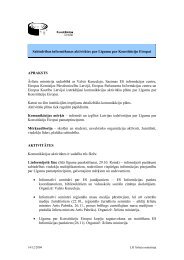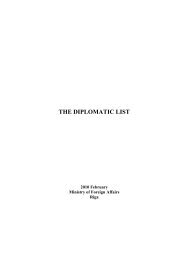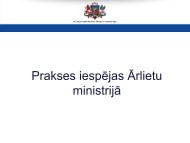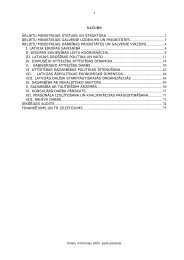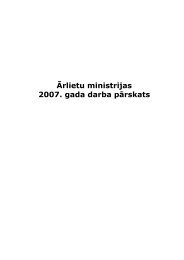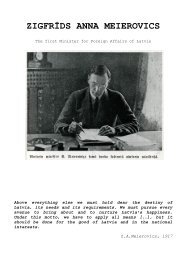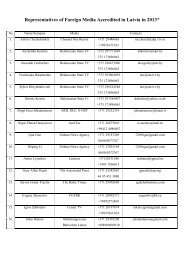Nr.2(10) / 2013.gada jūnijs - Par es.gov.lv
Nr.2(10) / 2013.gada jūnijs - Par es.gov.lv
Nr.2(10) / 2013.gada jūnijs - Par es.gov.lv
Create successful ePaper yourself
Turn your PDF publications into a flip-book with our unique Google optimized e-Paper software.
Russia and the EU Strategy for the Baltic Sea Region: bridging a (mis)connection gap 55IntroductionThe Baltic Sea Region (BSR) is not a high priority among Russiannational inter<strong>es</strong>ts. Bilateral relations with the EU and US, the Arctic and EastAsian regions are much more important for Moscow. Neverthel<strong>es</strong>s, the BSRstill has considerable significance for Russia for a number of reasons:•• This region is the only one where Russia has a common border withthe EU and, hence, serv<strong>es</strong> as a natural gateway for the transit of goods,servic<strong>es</strong> and people between Russia and the EU.•• The region’s importance has increased considerably with the launchof the Nord Stream project, which aims to ship Russian gas fromSiberia and the High North to the EU via a pipeline on the bottomof the Baltic Sea. In November 2011 the first pipeline was officiallylaunched and the second one was finished in October 2012.•• The Kaliningrad Region forms both a challenge and an opportunityfor Russia in its relations with the EU. On the one hand, its enclave/exclave status creat<strong>es</strong> various problems related to the freedom ofmovement of goods and people between Kaliningrad and mainlandRussia. On the other hand, the region is surrounded by EU territoryand can be seen as a promising venue for various cooperative projectsand, more generally, for experimenting in EU-Russian relations.•• Russia is still concerned about the status of the Russian-speakingminoriti<strong>es</strong> in Latvia and Estonia, although this issue is of much l<strong>es</strong>simportance than in the 1990s and no longer seen as a serious obstacleto Moscow’s bilateral relations with th<strong>es</strong>e Baltic Stat<strong>es</strong>.•• NATO enlargement has brought the alliance’s military structur<strong>es</strong>closer to Russian borders, led to the modernization of the armedforc<strong>es</strong> of the Baltic Stat<strong>es</strong> and Poland, as well as to the deploymentof military aircraft in Lithuania and US Patriot missil<strong>es</strong> in northernPoland (in Kaliningrad’s vicinity). Th<strong>es</strong>e mov<strong>es</strong> made Moscowsuspicious about US/NATO’s real intentions and even generated aRussian discussion on a possible rearmament of the Kaliningrad area.Th<strong>es</strong>e developments forced Moscow to see the region as a source ofpotential “hard” security threats again.



